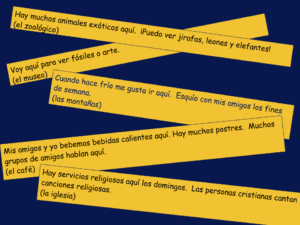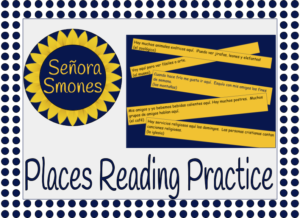This is the time of year I teach places and the verb ir in Spanish 1. I loosely follow the Realidades 1 textbook, however over the years I have supplemented their original Chapter 4A list to include more places, particularly cognates. My favorite thing about this chapter is that it is the perfect way to review previous material, particularly verbs and weather.
At the beginning of the unit, I always have my students use the mini white boards to draw pictures of the places. I find drawing is a nice ease into the chapter and students enjoy it. While they draw, I walk around the room and talk with my students, so it has two outcomes: vocabulary practice and relationship building! This year I also had them write at least one word or phrase they associate with the place. For example for las montañas they’d draw mountains and maybe write esquiar or Hace frío. I thought I’d get a lot of push back from my students if I asked them to write, but they took it as a challenge to write as many things as possible! I’m not sure why I didn’t do this sooner, but I will definitely keep doing it in the future! This lesson was the last one I did before school was closed so it sets my students up well to work at home on this unit.
One of the main tasks for my students in this unit is to read descriptions in Spanish of the different places on their list and then figure out which place is being described. For example: Voy aquí para ver fósiles o arte. → el museo. Each student is given a slip that has a description and the answer. They get up, find a partner and read the description to them. Once both partners have read their descriptions and figured out the other’s place, they switch slips and find someone one else to talk to. I do this multiple days in a row, rotating in different vocabulary slips so each word is used at least one day. I love doing this because I tell them they can’t use English, so they have to get creative, usually by using actions or other relevant vocabulary. I do allow them to cover up the answer with their finger and let their partner read the description if they need some extra help. It is amazing to see how much better they get at this activity after a couple days and how their pronunciation improves! After a few day so this, we play a class game, students are put into groups and race to read descriptions and determine which place is being described. 
I love doing this descriptions activity for variety of reasons:
- My students realize how much Spanish they have actually learned! I often hear them say, “Wow, I know a lot more Spanish than I thought!”
- I always write the descriptions using cognates and vocabulary my students already know, so they feel more confident with their reading skills. Like I said before, it is a great review of previous content. I love that they are receiving comprehensible input and seeing the Spanish language as a whole!
- Students tell me how fun this is, which has always floored me because they are using Spanish the whole time and don’t seem to realize or mind it! They love the challenge and it is a great activity that builds their language confidence.
This year since I won’t see my students in person, I’ll be relying more on Quizlet to help my students practice their vocabulary and descriptions. Although I’m hoping to find a way to have them play a class game!
You can check out my places reading activities on my Teachers Pay Teachers page.
